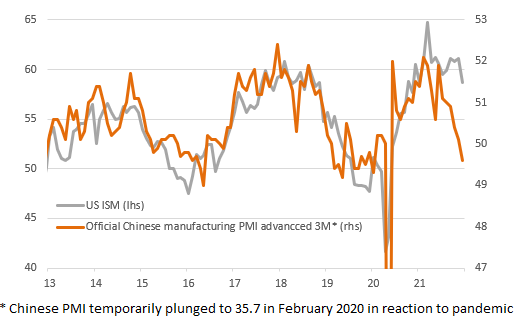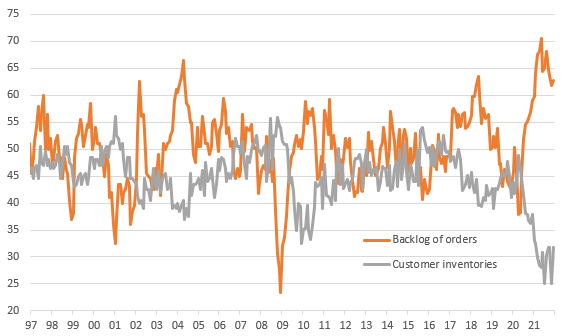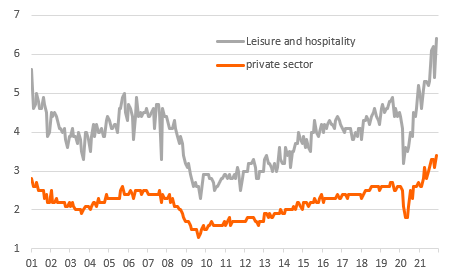While the Omicron wave is likely to temporarily weaken US growth, the first data releases of 2022 suggest the economy is fundamentally very strong with robust growth and inflation keeping the Federal Reserve on course for rate hikes.
ISM points to a robust manufacturing sector
We have had the first big data US releases to start the year and while they are a little softer than hoped at the headline level the details show an economy that was in great shape in the lead up to the holiday season.
Firstly, the ISM manufacturing index dropped to 58.7 from 61.1 whereas the consensus was for a slightly stronger 60.0 figure with optimism largely centered on good regional indicators. However, the details are certainly stronger than the headline implies since there were only very modest declines in production and orders while employment actually rose to 54.2 from 53.3 and the backlog of orders increased to 62.8 from 61.9 – remember anything above 50 is in expansion territory. There doesn’t appear to be much to worry about from a demand perspective in the economy. Moreover, the chart below shows how well the US is performing relative to China’s PMI.
US manufacturing outperforming China's (ISM & PMI readings)
Source: Macrobond, ING
Lower for good reasons
Instead, the headline index was dragged down by a big drop in supplier delivery times (64.9 from 72.2) – which in these current stressed times is actually a good thing as it hints that supply chain bottlenecks might be easing. A modest improvement in customer inventories (although still at very weak levels that are deep in contraction territory at 31.7) backs this up. Certainly a better story than just looking at the headline implies.
Prices paid also fell sharply (68.2 versus 82.4) – a positive – but the issue of strong demand versus a lack of supply means that manufacturers continue to have pricing power. A massive backlog of orders at a time when you know your customers are desperate – as indicated by contracting customer inventories – means that price pressures will remain elevated for some time.
Corporate pricing power persists
Source: Macrobond, ING
Private sector quit rate hits new high
Meanwhile, the Job Openings and Labor Turnover Survey data show the number of US job openings dipped to 10.53mn from 11.1mn (consensus 11.1mn), but this is still showing a huge number of vacancies in the US with the softness in employment growth clearly down to a lack of available workers rather than any weakness in demand for staff.
Again the details show a stronger economic story with a record 4.5mn people quitting their jobs in November. This is equivalent to 3% of all workers quitting to move to a new employer, which takes us back to match the series high for the 21-year survey. For private-sector workers, it did hit an all-time high of 3.4%.
US quite rates - proportion of workers quitting their jobs to move to a new employer (% of workers)
Source: Macrobond, ING
The Fed is watching and rate hikes are coming
This survey has taken on added importance since the December FOMC. When asked at the December FOMC press conference about the best signals surrounding maximum employment, Chair Powell responded “the quits rate is really one of the very best indicators… because people quit because they feel like they can get a better job and there's, you know, record amounts, historically, high levels of that going on suggesting, again, that you've got a very tight labor market."
The Omicron wave remains an obvious concern and is likely to see some consumer caution, while increased worker absences mean more bottlenecks and supply chain strains. Nonetheless, there is optimism that the health impact and economic disruption may be less intense and lasting than for the Delta wave. Today’s data shows the economy is in a good position to weather it and will keep market expectations for at least three rate hike expectations in place for this year.
Read the original analysis: US economy in good position to weather Omicron storm
Content disclaimer: This publication has been prepared by ING solely for information purposes irrespective of a particular user's means, financial situation or investment objectives. The information does not constitute investment recommendation, and nor is it investment, legal or tax advice or an offer or solicitation to purchase or sell any financial instrument. Read more here: https://think.ing.com/content-disclaimer/
Recommended Content
Editors’ Picks
AUD/USD stands firm above 0.6500 with markets bracing for Aussie PPI, US inflation

The Aussie Dollar begins Friday’s Asian session on the right foot against the Greenback after posting gains of 0.33% on Thursday. The AUD/USD advance was sponsored by a United States report showing the economy is growing below estimates while inflation picked up. The pair traded at 0.6518.
EUR/USD faces a minor resistance near at 1.0750

EUR/USD quickly left behind Wednesday’s small downtick and resumed its uptrend north of 1.0700 the figure, always on the back of the persistent sell-off in the US Dollar ahead of key PCE data on Friday.
Gold soars as US economic woes and inflation fears grip investors

Gold prices advanced modestly during Thursday’s North American session, gaining more than 0.5% following the release of crucial economic data from the United States. GDP figures for the first quarter of 2024 missed estimates, increasing speculation that the US Fed could lower borrowing costs.
Bitcoin price continues to get rejected from $65K resistance as SEC delays decision on spot BTC ETF options

Bitcoin (BTC) price has markets in disarray, provoking a broader market crash as it slumped to the $62,000 range on Thursday. Meanwhile, reverberations from spot BTC exchange-traded funds (ETFs) continue to influence the market.
US economy: Slower growth with stronger inflation

The dollar strengthened, and stocks fell after statistical data from the US. The focus was on the preliminary estimate of GDP for the first quarter. Annualised quarterly growth came in at just 1.6%, down from the 2.5% and 3.4% previously forecast.


